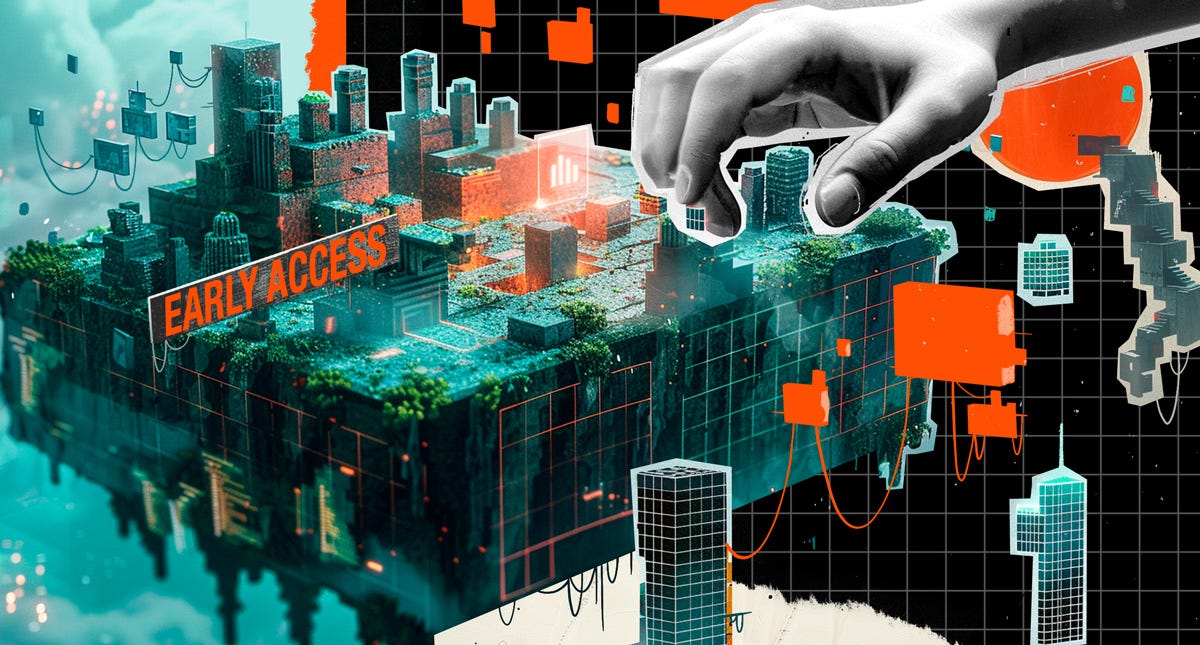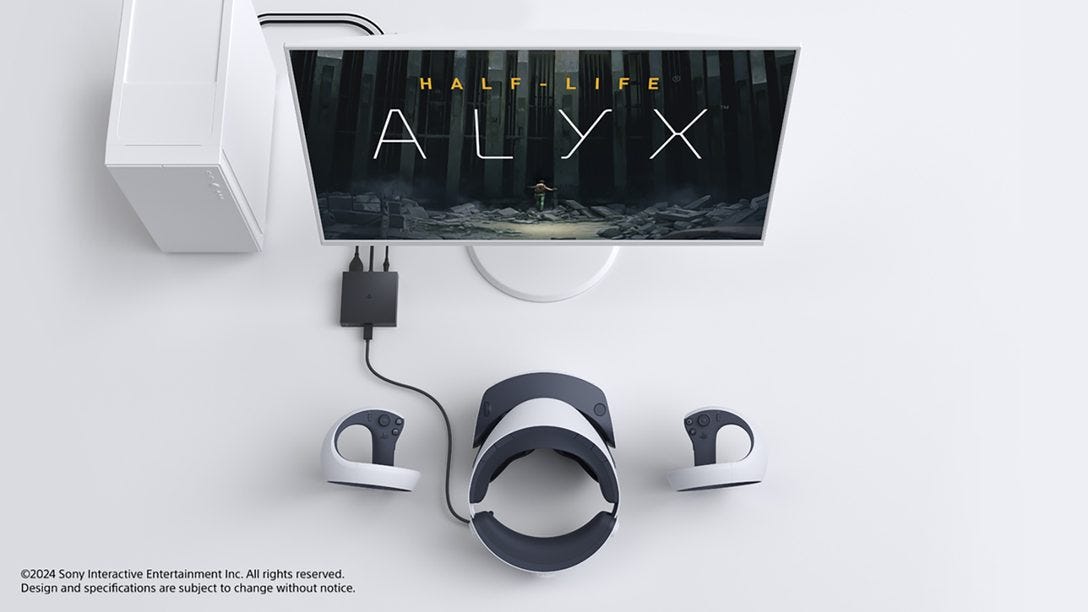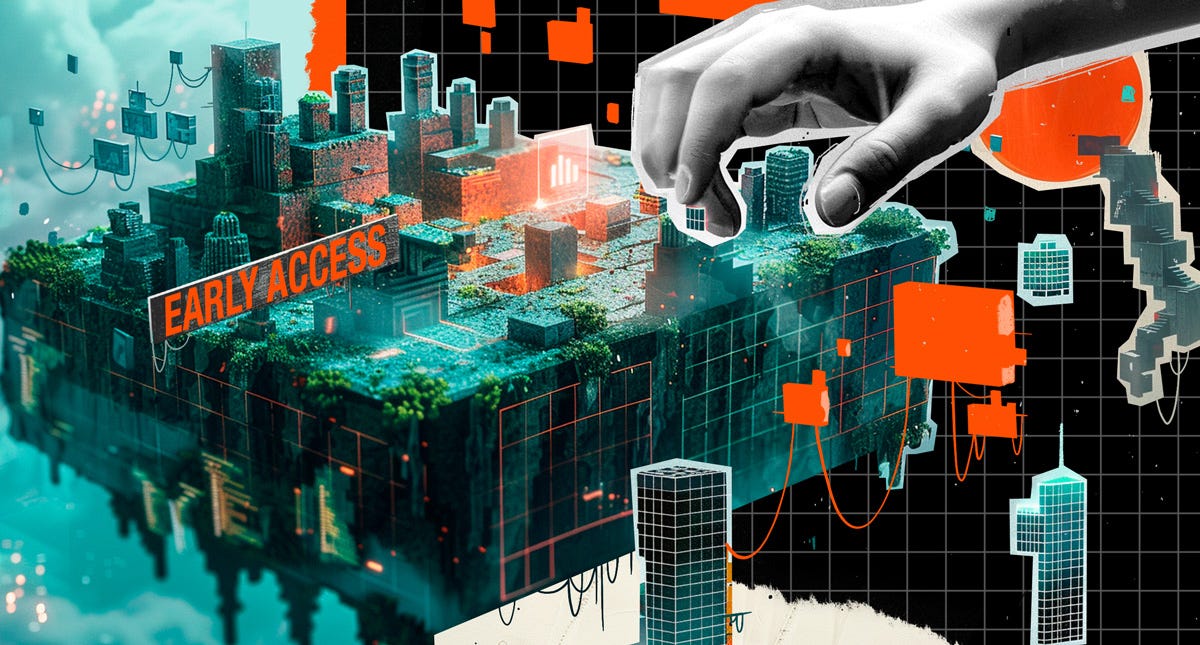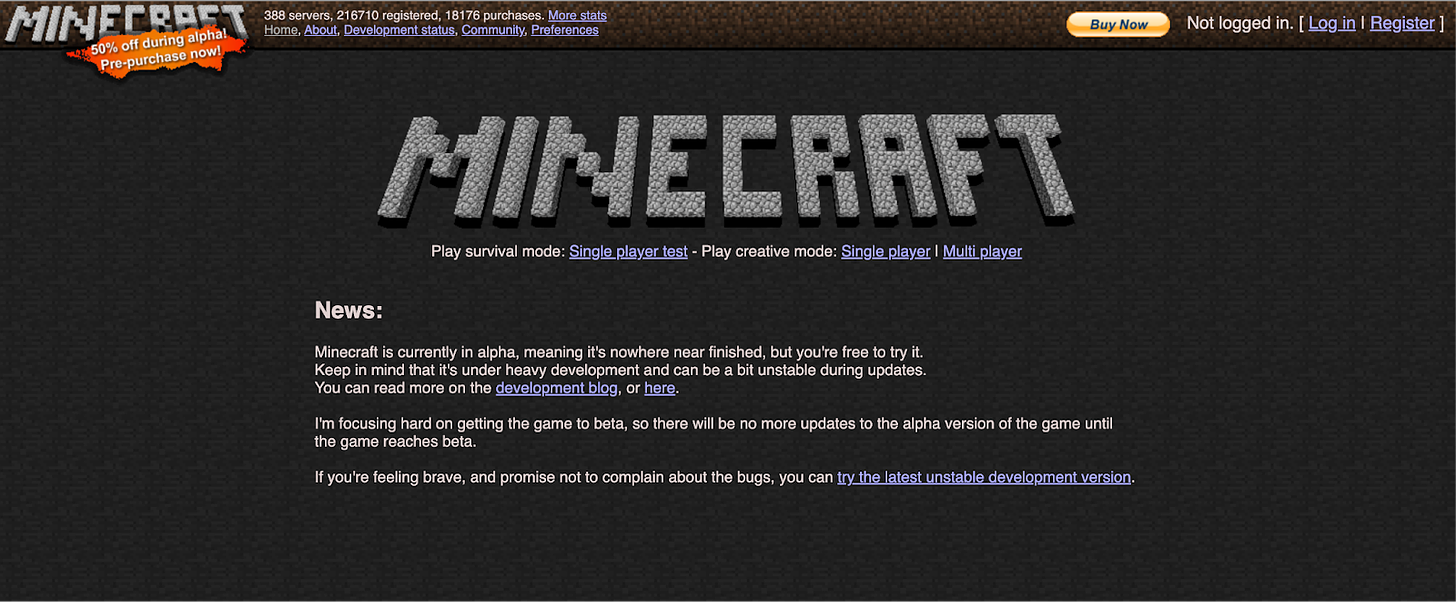Works In Progress: Top Developer Tips For Steam Early Access
We asked the creators of Palword, Valheim, Slime Rancher 2, Abiotic Factor, and FOUNDRY for advice on launching Early Access titles.
Though Steam Early Access was originally limited to just a handful of games, in the 11 years since its launch the program has since become one of the primary ways game developers reach audiences and a critical part of many go-to-market roadmaps.
With Early Access games as big as Hades 2, Baldur’s Gate 3, and Palworld taking the world by storm, more devs than ever are wondering whether the program is right for them.
To get some informed opinions on the subject, A16Z GAMES interviewed five studios behind some of the biggest current Steam Early Access titles, including Pocketpair (Palword), Iron Gate Studios (Valheim), Monomi Park (Slime Rancher 2), Deep Field Games (Abiotic Factor), and Channel 3 Entertainment (FOUNDRY).
That story below. First, this week’s most futuristic news links.
News From the Future
🥽 VR Tech is Going Cross-Platform (PlayStation)
Following April’s announcement that Meta is opening up Quest OS to a selection of third-party headset makers (including Xbox), PlayStation announced this week that an official adapter for its PS VR2 headset will enable full compatibility with thousands of SteamVR titles. The future of VR looks a lot more connected than some expected.
☀️ Summer Game Fest 2024 is this Friday (The Game Awards)
Geoff Keighley’s other annual blowout game trailer showcase goes live this Friday at 2pm PT / 5pm EST. Although big game reveals are expected, Keighley has said in a recent Q&A that "the show is largely focused on, I think, existing games that have new updates for fans."
🎮 At Least 15 Gaming Showcases Planned for June (GamesIndustry.biz)
Summer Game Fest isn’t the only show in town. This helpful guide from GI.biz catalogues at least 15 showcases planned this month, including IGN Live (June 7), an Xbox Games Showcase (June 9), and a Nintendo Direct at some point later in the month. E3 may be gone, but its legacy continues.
🤖 Larian is Adding Official Mod Support to Baldur’s Gate 3 (Steam)
One of the major problems affecting the mod scene is the fact that official updates often break community-made mods. With official mod support for BG3, Larian is hoping to overcome this problem and also enable mods for the game on consoles.
Works In Progress: Top Developer Tips For Steam Early Access
Is it okay to sell a game before it’s done?
It’s a question that now seems passé, but fifteen years ago this was still a hotly debated topic. Then, in the summer of 2009, Minecraft came along and challenged all of our assumptions.
On the game’s official website, developer Markus Persson was upfront about the fact that the game wasn’t done. It was labeled as an alpha and was priced with a prominent discount.
In later updates, Persson made a more direct effort to explain the premise of Minecraft—The November 2010 version of the site says “Minecraft is a game about placing blocks while running from skeletons. Or something like that.” But in these early days, much effort was spent explaining what an “alpha” actually is.
This was early access before Early Access was a thing. It was also happening at a time when “crowdfunding” hadn’t yet gotten a grip in the online zeitgeist—although Kickstarter launched in April of 2009, most of its most notable video game success stories came later, like Kentucky Route Zero (2011) OctoDad 2 (2011), Broken Age (2012), and Shadowrun Returns (2012).
On March 20th, 2013, Valve changed the game with its announcement of Steam Early Access. The initial wave of 12 Early Access games included titles that went on to become PC gaming classics: Kerbal Space Program, Prison Architect, and ARMA 3 among them.
Just 11 years later, Steam Early Access has become such a well-established method for games to go to market that even AAA studios like Larian (Baldur’s Gate 3) and critical darling studios like Supergiant (Hades 2) have used it to craft what ultimately become cross-platform titles—effectively making Steam the place where the world’s biggest games come together, all live and in front of players.
With more and more devs releasing in Early Access—and achieving millions in sales while doing so—many studios are starting to seriously consider the program for their own games. This begs the question: What’s the right way to go about it?
To find out, A16Z GAMES reached out to five leading developers of Steam Early Access titles to ask for their advice. We asked each participant the same set of questions.
Their answers, lightly edited for clarity, are below.
Question 1: What % of a game should be “finished” before it’s ready to go into Early Access?
With many games launching in Early Access as polished, discrete experiences, it can sometimes be hard to tell the difference between an Early Access game and a full launch.
A number of devs we spoke with say that’s intentional, and it’s necessary due to rising player expectations.
“I think most players aren't really approaching the game as an actual Early Access or beta, but are just anxious to play the game that they are hyped about and will review it as any other game. I believe the best way is to make sure that you are giving the player the full intended experience even at your Early Access launch.
That doesn't mean you need to be content complete, but at least the first few hours should feel basically exactly as you want your game to be at launch, both content wise and polish wise. This includes the startup and menus as well, not a bunch of things that don't work or say ‘work in progress.’
If you don't have multiplayer yet, just skip the button in the menu completely so that players enjoy what they get rather than run into lots of unfinished corners of the game.”
—Jonathan Smårs, Lead Engineer and Game Designer at Iron Gate Studios, creators of Valheim
A recurring theme in the responses we gathered was to avoid overt in-game reminders that make the experience feel unfinished.
“Generally I think it’s less ‘how much’ is finished and more ’what’ is finished. A game entering EA should ideally have some satisfying portion of the game available that players can play repeatedly, so that the amount of entertainment they get out of it is somewhat elastic. EA is a great time to get feedback and test assumptions about playtime, so carving out areas of your EA experience that will put that to the test with repeated play is ideal.
We have a rule here that any release should be hardened and players shouldn’t really be aware the game is EA if they’re just trying to enjoy the experience. We don’t ship half baked systems, known buggy content, or have dev ‘under construction’ signs in game if we can at all help it.”
—Nick Popovich, Co-Founder and CEO of Monomi Park, creators of Slime Rancher 2
Palworld’s Bucky offered one useful heuristic for devs thinking about this problem: focus on early and mid-game content over end-game loops.
“It’s difficult to put a percentage on it, but the core gameplay loops should be in place with well-defined early and mid-game systems. Developing the “end-game” can be difficult and is something that can change depending on player feedback, so we decided to focus more on the early and mid-game loops, and are now putting a lot of effort into expanding the end-game systems.
Early Access is a great opportunity for players to help shape the future of a game. It isn’t that we don’t have our own vision for how the game will be at 1.0, but perhaps players can help us refine that vision and in turn help us make an even better game.”
—John "Bucky" Buckley, Global Community Manager / Business Development at Pocketpair, creators of Palworld
Ultimately, if players finish playing your game feeling satisfied, yet still wanting more, you’re in a great position.
“A successful Early Access game is all about re-engagement. It's ok for players to finish the game and wish there was more content—this is something you can expand during Early Access.
What you can't afford is players feeling that "what's here isn't very fun." The core gameplay loop should be established, and the fun should be evident. Treat what you have as if it's a full release in terms of polish. Respect players' time—they are excited enough about your game to play it during its development, so ensure that what you deliver is deserving of their trust.
If you can do that you can reactivate players with each update and grow the game.”
—Mark Laprairie, President and Co-Founder, Channel 3 Entertainment, creators of FOUNDRY
Question 2: How much marketing/promotion is needed before launching in Early Access? Is it effectively the same as the launch for a game?
Continuing along the theme of differentiating between Early Access launches and “full” launches, we asked devs how they think about go-to-market strategies for Early Access launches.
For Deep Field’s Geoff Keene, Steam success is heavily impacted by one KPI: wishlists.
“You should always promote before going into Early Access. Wishlists are massive. Get the wishlists. It's one of the biggest advertisers when the game becomes available.”
—Geoff “Zag” Keene, Design Director / CEO at Deep Field Games, creators of Abiotic Factor
The rationale for aggressively promoting your Early Access is simple: it might be your only real shot.
“You will probably get the chance to do marketing at your 1.0 launch, but if your Early Access launch fails you may never even get there. Treat your early access launch as you would your full launch and be happy you get two chances for launch. There are of course games that start small during Early Access and build up over time and sell much more at release as well.”
—Jonathan Smårs, Valheim
So how does one drive meaningful interest before that Early Access period, beyond just launching a Steam page and gathering wishlists?
“It depends on the game but for Palworld, it was important to establish a fanbase early. We didn't want to dedicate all our resources towards promotion but we also wanted to try and attract an audience, so one big part of our strategy was releasing 1-2 high-quality trailers every year.
Inviting influencers and content creators to play the game was another way that we tried to build a fanbase early. Of course, you want top-tier streamers playing your game, but that's not always realistic, so it's good to also consider smaller ones who are more likely to stream your game, for example, because it fits their niche.
For the official 1.0 release we have a few things planned to promote the game on a larger scale, but for early access, we found that the two methods above were the most effective!”
—John “Bucky” Buckley, Palworld
Prior to co-founding Channel 3 Entertainment, Mark Laprairie was an early lead on the indie hit Don’t Starve Together. His experience on that game taught him to think beyond Steam when looking for advantages.
“The market is crowded, and it's important to seek an ‘unfair’ advantage. For instance, with Don’t Starve Together, we gave away 80,000 copies to our external testing community for free.
For Foundry, we sold nearly 10,000 ‘alpha’ copies on the boutique indie storefront ‘itch.io’ before launching on Steam. This meant that, in addition to wishlists and those we attracted through influencer partnerships and ad buys, we had a substantial group of players ready to engage with the game right at launch. Additionally, paying customers provided more representative feedback to help us improve the game prior to launching on Steam.”
—Mark Laprairie, FOUNDRY
Question 3: How much private playtesting do you think devs should do before going into Early Access?
With so much of the advice encouraging devs to treat Early Access more like a full launch, it’s natural to start thinking about playtesting strategies that can help devs develop a more polished experience before going into Early Access.
“You need honest feedback on your designs, and friends and family typically can't provide that. Consider releasing a demo, publishing an early alpha version on itch.io or using the Steam playtest feature to get the feedback you need. Iterate on game design with external testing as much as financially feasible, because making your game better is one of the few things in your control.”
—Mark Laprairie, FOUNDRY
Some we spoke with felt that, done right, a limited playtest period might be enough:
“Perhaps one or two playtests are enough for an Early Access launch.
Again, the answer may vary depending on the game but for Palworld we found this was enough to identify the core issues and address them before releasing the game.Both of our playtests lasted around a week, and we invited players from our Discord to test the game. This proved to be quite effective, and we gathered a lot of useful info which helped us have a smoother launch.”
—John “Bucky” Buckley, Palworld
But all agreed on the importance of playtesting:
“Playtest is almost everything. You can even combine playtesting and wishlisting into the same promotion. Get real players telling you if your game is fun, and get those players to wishlist it, and have their friends wishlist it. It's all combined, none of these techniques live in a vacuum.”
—Geoff “Zag” Keene, Abiotic Factor
Question 4: Are there any downsides to being in Early Access?
One common concern you’ll hear from devs: Is there a risk of the Early Access label driving some players to wait to buy your game—or even to avoid it altogether?
Across the board, the devs we interviewed agreed that this is a real concern. But, the logic goes, it’s likely not worth worrying about so long as your game is in a genre that’s a strong fit for Early Access.
“Some players simply won't ever touch Early Access, but that's just not your audience yet. Some genres do a lot better in Early Access, but I think it's pretty obvious which ones those are—more open-ended games, for the most part.”
—Geoff “Zag” Keene, Abiotic Factor
Others expanded on this point about the importance of genre fit:
“Not all games are well-suited for Early Access. Games that rely on consumable content or linear narratives are poor candidates. Long-tail retaining games, which function like a service, benefit the most from Early Access because players return with each major update, attracting new players and reactivating existing ones. If you don't believe your title can achieve this, it's better to skip Early Access and aim for a splashy 1.0 launch.”
—Mark Laprairie, FOUNDRY
Another risk multiple devs called out: If your game makes a bad first impression, that can seriously damage your future prospects.
“Plenty of players are content to wait until full launch, and that’s fine. So the only real downside to EA is you ship something so half baked or buggy that players reach the consensus it’s bad before you had a chance. So just don’t do that! Ship something whose individual pieces that are meant to be enjoyed feel whole. If players keep bumping up against your frayed wiring it can get taxing and cause them to disengage.”
—Nick Popovich, Slime Rancher 2
Because not all developers who release games on Early Access actually follow through on your promises, it’s critical to do everything you can to prove you’re a serious developer—and not one of the scammers.
“Early Access, especially on Steam, has a bit of a stigma at the moment for having ‘scam’ or ‘abandoned’ games. These comments and opinions can put off players and can quickly spiral out of control, materializing as a negative review or an overrun forum. It is something that we are very careful about, but ultimately the only way to overcome this is to put out consistent updates and try to be as transparent about development as possible with our players.”
—John “Bucky” Buckley, Palworld
Iron Gate’s Jonathan Smårs echoed some of the above concerns and challenged developers to be honest with themselves about whether they’re really really a fit for the program.
“I firmly believe Early Access is not for everyone and it depends mainly on the type of game you are making. There are many cases where Early Access really hindered the game's completion.
While you do get two launches, you are also splitting up your chance to snowball at release since you are splitting up your market by first selling to those people who are willing to buy Early Access games, and then much later to the rest of the market, and by then interest may have died down significantly. Also, games that get off to a bad Early Access launch may even be prematurely cancelled, because it's the type of game that most players will want to play in its entirety at full release, like single player games or games without much replayability.
My advice is that if you're not entirely sure that Early Access is for you or that you absolutely need to, that it's probably best to skip Early Access completely and just finish and polish your game as much as possible before release. The gaming market is so saturated and you mainly get one shot if even that, and you lower your chances of giving a great impression by releasing too early.”
—Jonathan Smårs, Valheim
Question 5: Do you have any “spicy” or contrarian takes on Early Access or the Steam ecosystem more broadly?
To wrap our discussions with devs, we handed the mic to them and said, basically, “talk your talk.”
The topics they wanted to dish on included the changing nature of Early Access…
“I’m not sure if it is spicy, but I do personally think the meaning of Early Access has changed a lot in the last 5-10 years.
Before it was a promise, a way to invite players in early and have them help shape the future of the game. Developers would say ‘Hey, we are going to make this game and here is the roadmap, but we want you guys to join in early and help us squash bugs and problems along the way.’
Now it seems like there are more and more games with looser goals, perhaps launching early as a means to secure funding to continue development while figuring things out along the way. I’m not saying this is bad, but it is perhaps becoming a new substitute for the traditional investor-seeking methods of the past. It certainly has helped a lot more solo developers and small teams to fund their dream games, so perhaps it’s a positive thing overall?”
—John “Bucky” Buckley, Palworld
… as well as Valve’s revenue split…
“I think indie devs should take home more of their earnings (Steam's cut is quite large!) but I think all developers feel this way at every level. Steam is still the best platform to ship for on PC, no contest. Nothing else comes close to that level of support and exposure.”
—Geoff “Zag” Keene, Abiotic Factor
… but ultimately these are all devs who strongly believe in the opportunities Early Access has created for game makers.
“I think Early Access represents one of the few meaningful changes to happen to how games are distributed in all of the history of games.
We started with quarters in a machine and then you could bring them home in a box, and that stayed the same for over 30 years before Valve popularized buying games online as a thing with Steam. And then for about the last ten years devs have been able to ship games in a partially complete state, with all the benefits this entails, in a way that is sanctioned by the biggest distributor of games in the world.
It’s hard to understate how big of a change that has been for games, how many opportunities it has opened for devs, and how many new games have made it to players that otherwise would never have existed.”
—Nick Popovich, Slime Rancher 2
That wraps the A16Z GAMES survey on Early Access.
Are there other game dev topics you’d like to see us discuss with the industry’s leading voices? Hit reply and let us know.
🍸 Join our Tech x Games Mixer at NY #TechWeek!
Headed to Tech Week? Hit this link to register for an exclusive event designed to connect current and aspiring founders, investors, and creators.
⏰ When: Thursday, June 6 at 6:00 PM - 9:00 PM EDT
📍 Where: New York, New York. Register to get the address.
❄️ More From A16Z GAMES
In the latest episode of our original A16Z series, "By Design," we ask the question, "What power do players have in the market?"
The recent Playstation / Arrowhead situation alongside Escape from Tarkov's aggressive "non-DLC" release has forced the hand of players to not only shout on social media, but also vote with their wallets and reviews.
Danny O’Dwyer tells the story.
💼 Jobs Jobs Jobs
There are currently around 150 open jobs listings across both the A16Z GAMES portfolio and our SPEEDRUN portfolio. For the freshest games industry jobs postings, be sure to follow our own Caitlin Cooke and Jordan Mazer on LinkedIn.
Join our talent network for more opportunities. If we see a fit for you, we'll intro you to relevant founders in the portfolio.










Useful read, I would love to see a similar deep dive on whether Steam's network effects justify the 30% cut, especially vs Epic Game Store's 12%.
(Or even Itch? Has anybody ever successfully launched a game there?)
If my math is right, you'd have to sell ~25% more copies on Steam to contend with EGS, but perhaps the lower friction to wishlisting is worth it.